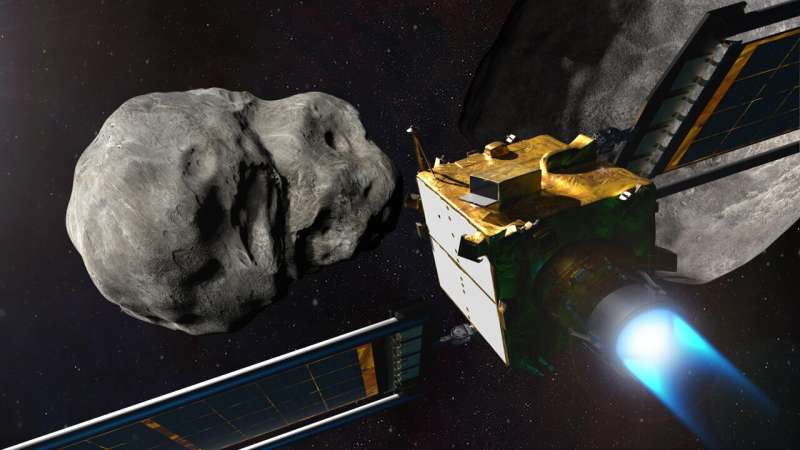NASA Space Technology

When NASA’s Double Asteroid Redirection Test (DART) spacecraft collided with an asteroid moon called Dimorphos in 2022, the moon was significantly deformed—creating a large crater and reshaping it so dramatically that the moon derailed from its original evolutionary progression—according to a new study. The study’s researchers believe that Dimorphos may start to “tumble” chaotically in its attempts to move back into gravitational equilibrium with its parent asteroid named Didymos.
“For the most part, our original pre-impact predictions about how DART would change the way Didymos and its moon move in space were correct,” said Derek Richardson, a professor of astronomy at the University of Maryland and a DART investigation working group lead. “But there are some unexpected findings that help provide a better picture of how asteroids and other small bodies form and evolve over time.”
The paper published in Planetary Science Journal on August 23, 2024 by a team led by Richardson detailed notable post-impact observations and described possible implications for future asteroid research.
One of the biggest surprises was how much the impact with DART changed the shape of Dimorphos. According to Richardson, the asteroid moon was originally oblate (shaped like a hamburger) but became more prolate (stretched out like a football) after the DART spacecraft collided with it.
“We were expecting Dimorphos to be prolate pre-impact simply because that’s generally how we believed the central body of a moon would gradually accumulate material that’s been shed off a primary body like Didymos. It would naturally tend to form an elongated body that would always point its long axis toward the main body,” Richardson explained. “But this result contradicts that idea and indicates that something more complex is at work here. Furthermore, the impact-induced change in Dimorphos’ shape likely changed how it interacts with Didymos.”
Richardson noted that although DART only hit the moon, the moon and the main body are connected through gravity. The debris scattered by the spacecraft on impact also played a role in the disturbed equilibrium between the moon and its asteroid, shortening Dimorphos’ orbit around Didymos. Interestingly, Didymos’ shape remained the same—a finding that indicates that the larger asteroid’s body is firm and rigid enough to maintain its form even after losing mass to create its moon.
According to Richardson, Dimorphos’ changes have important implications for future exploration efforts, including the European Space Agency’s follow-up mission to the Didymos system slated for October 2024.
“Originally, Dimorphos was probably in a very relaxed state and had one side pointing toward the main body, Didymos, just like how Earth’s moon always has one face pointing toward our planet,” Richardson explained. “Now, it’s knocked out of alignment, which means it may wobble back and forth in its orientation. Dimorphos might also be ‘tumbling,’ meaning that we may have caused it to rotate chaotically and unpredictably.”
The team is now waiting to find out when the ejected debris will clear from the system, whether Dimorphos is still tumbling in space and when it will eventually regain its previous stability.
“One of our biggest questions now is if Dimorphos is stable enough for spacecraft to land and install more research equipment on it,” he said. “It could take a hundred years to see noticeable changes in the system, but it’s only been a few years since the impact. Learning about how long it takes Dimorphos to regain its stability tells us important things about its internal structure, which in turn informs future attempts to deflect hazardous asteroids.”
Richardson and his team hope that Hera will provide more information about DART’s impact. By late 2026, Hera will arrive at the binary asteroid system containing Dimorphos and Didymos to assess the internal properties of both asteroids for the first time, providing a more detailed analysis of the DART mission and its implications for the future.
“DART gave us insight into complicated gravitational physics that you can’t do in a lab, and all of this research helps us calibrate our efforts to defend Earth in the event of an actual threat,” Richardson said. “There’s a nonzero chance that an asteroid or comet will approach and endanger the planet. Now, we have an additional line of defense against these kinds of external threats.”
More information:Derek C. Richardson et al, The Dynamical State of the Didymos System before and after the DART Impact, The Planetary Science Journal (2024). DOI: 10.3847/PSJ/ad62f5
Citation:NASA’s DART impact permanently changed the shape and orbit of asteroid moon, new study shows (2024, August 23)retrieved 23 August 2024from https://phys.org/news/2024-08-nasa-dart-impact-permanently-orbit.html
This document is subject to copyright. Apart from any fair dealing for the purpose of private study or research, no part may be reproduced without the written permission. The content is provided for information purposes only.
Discover more from Tamfis
Subscribe to get the latest posts sent to your email.








